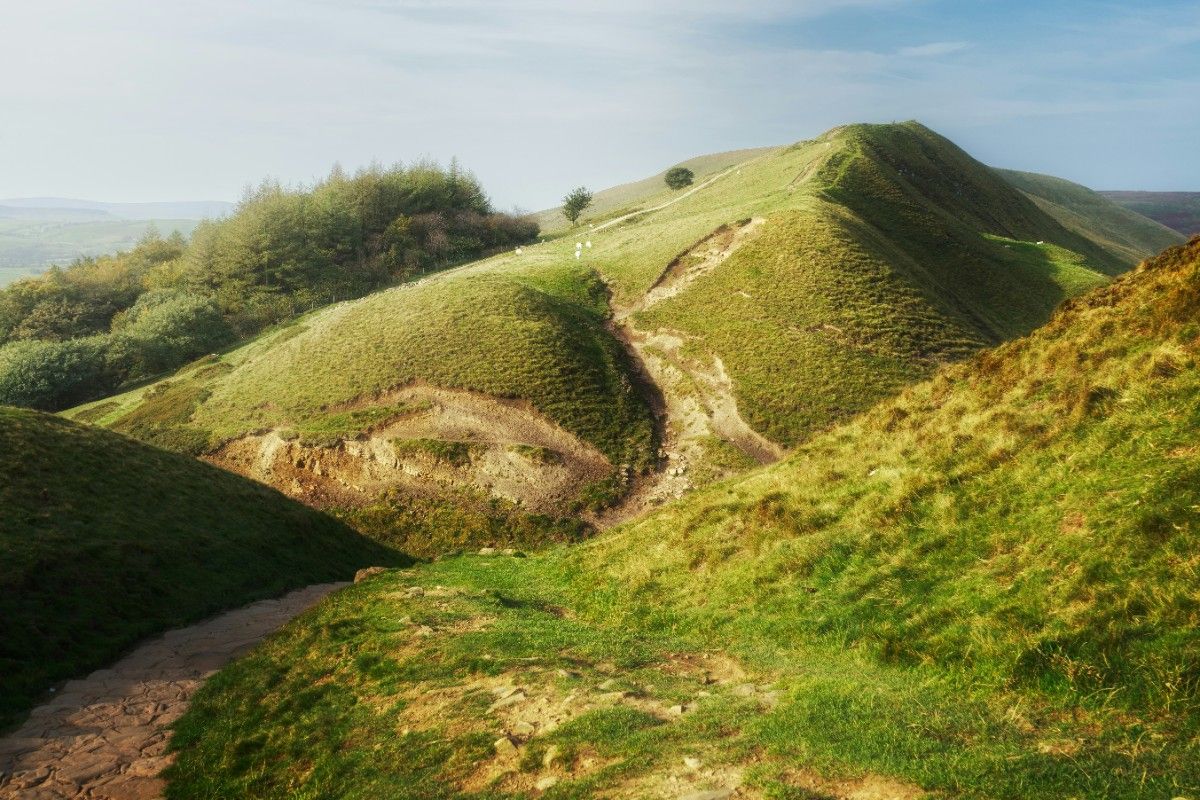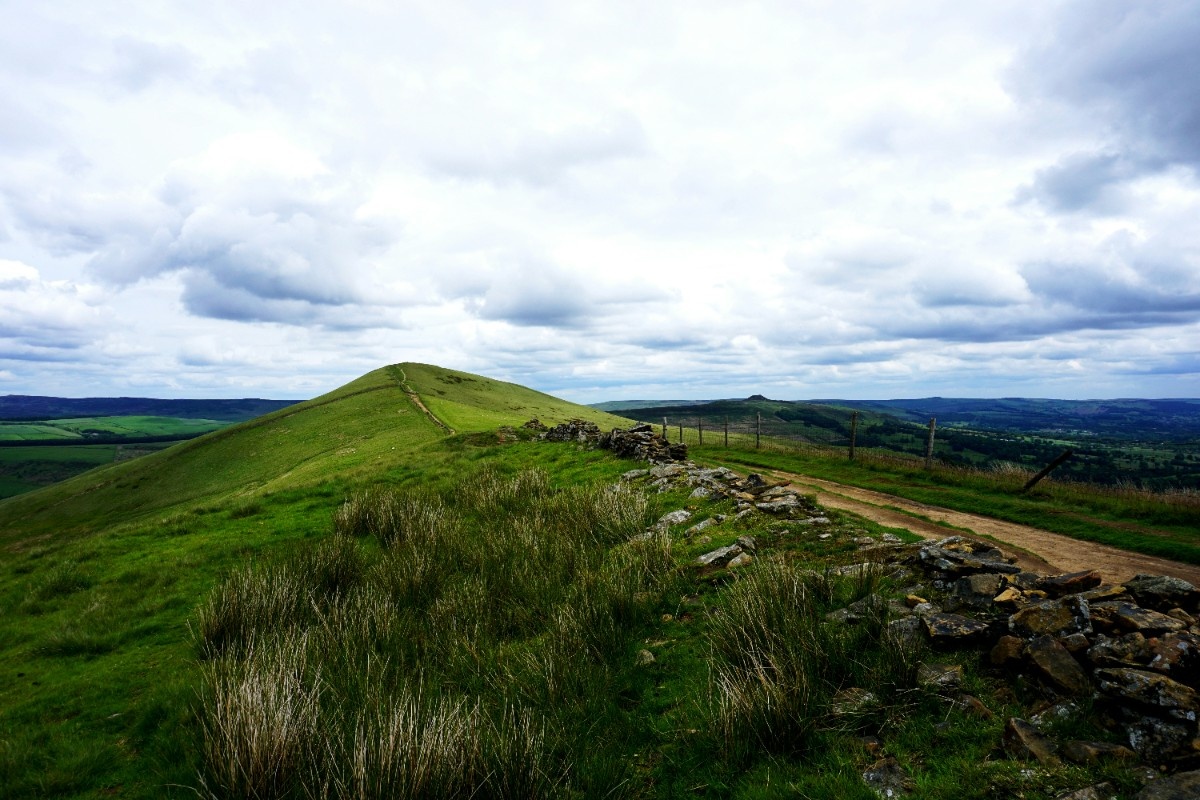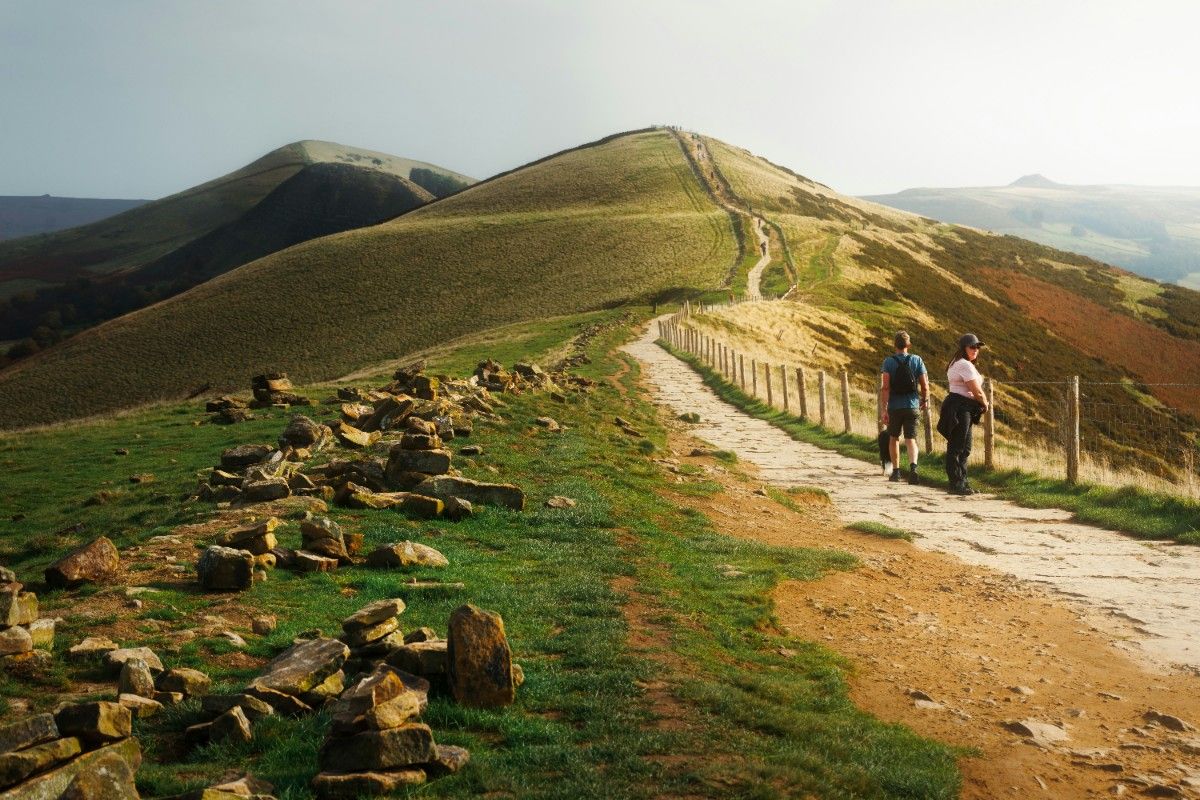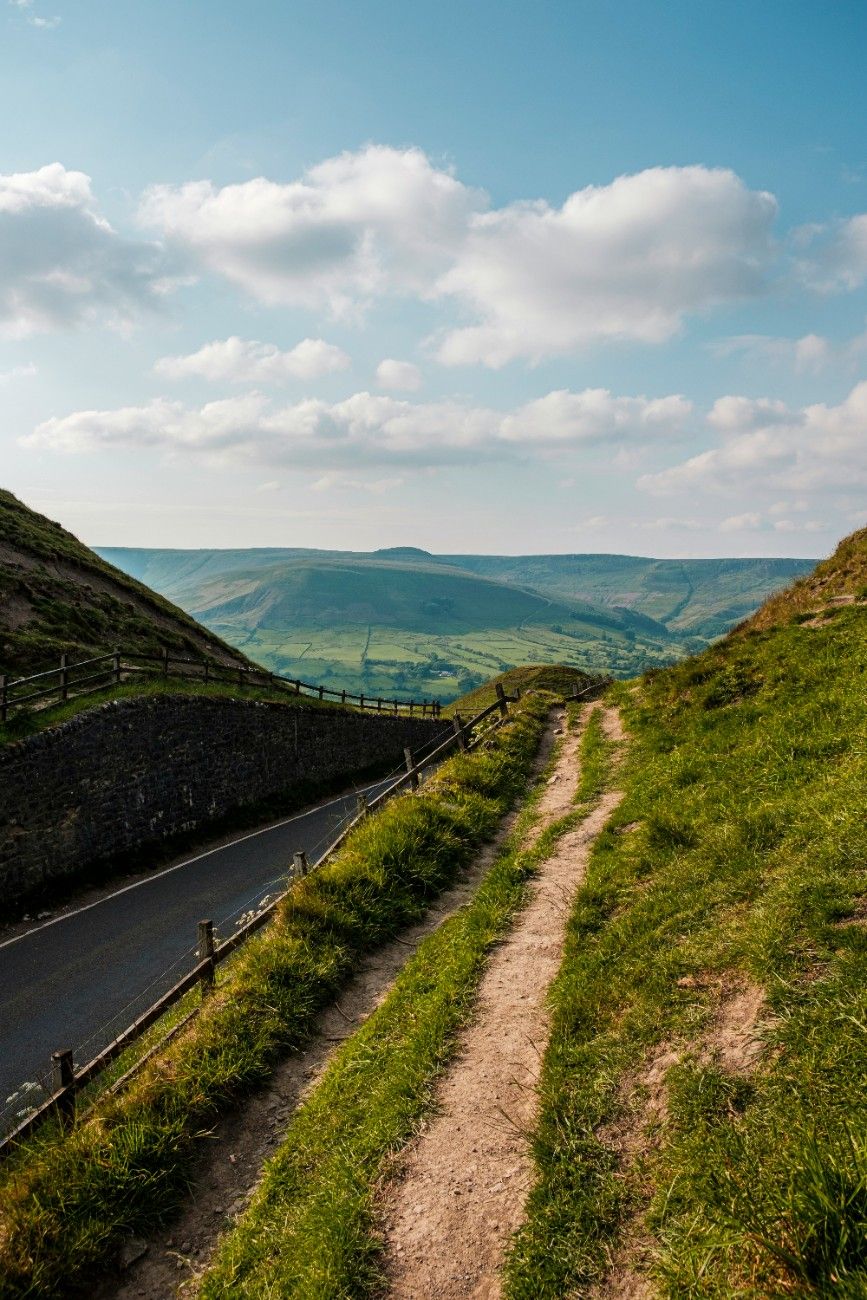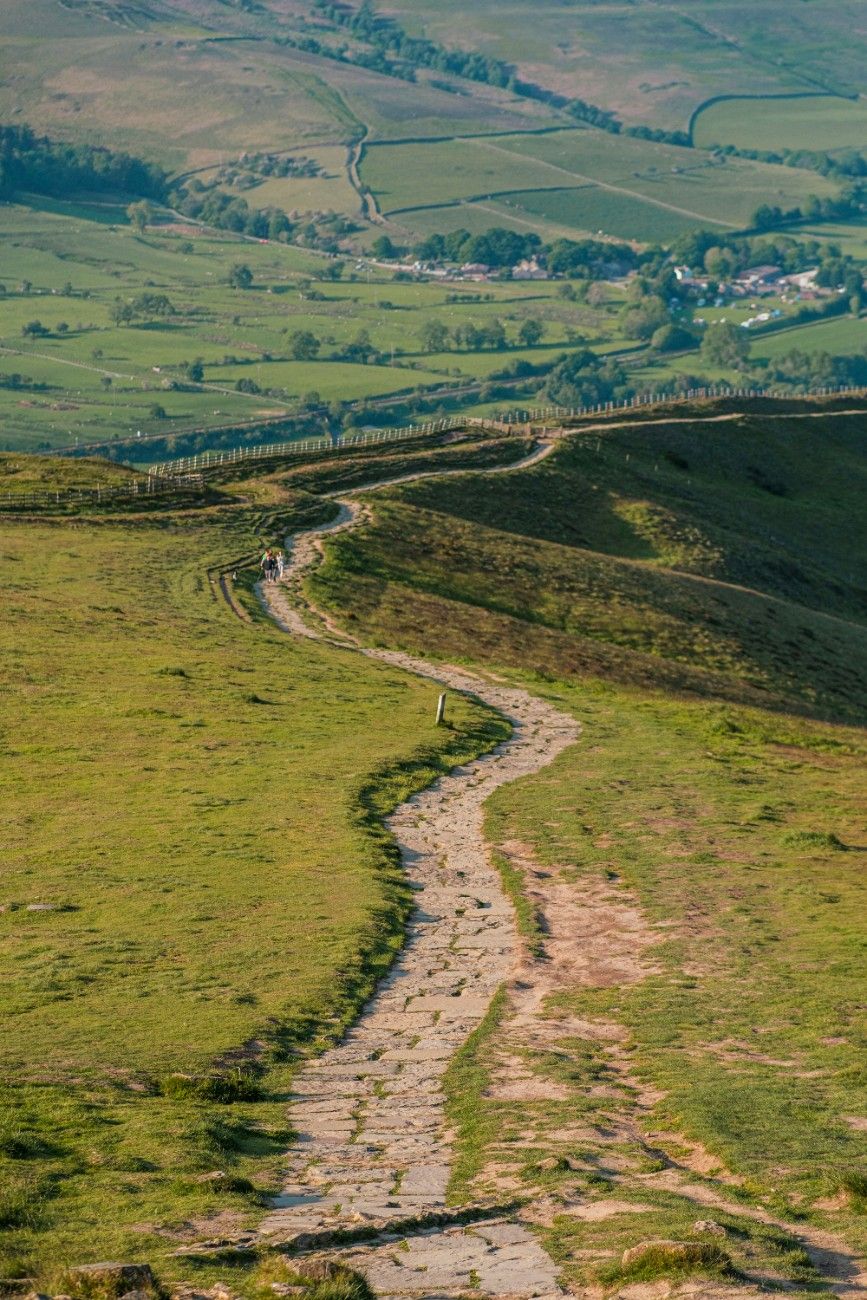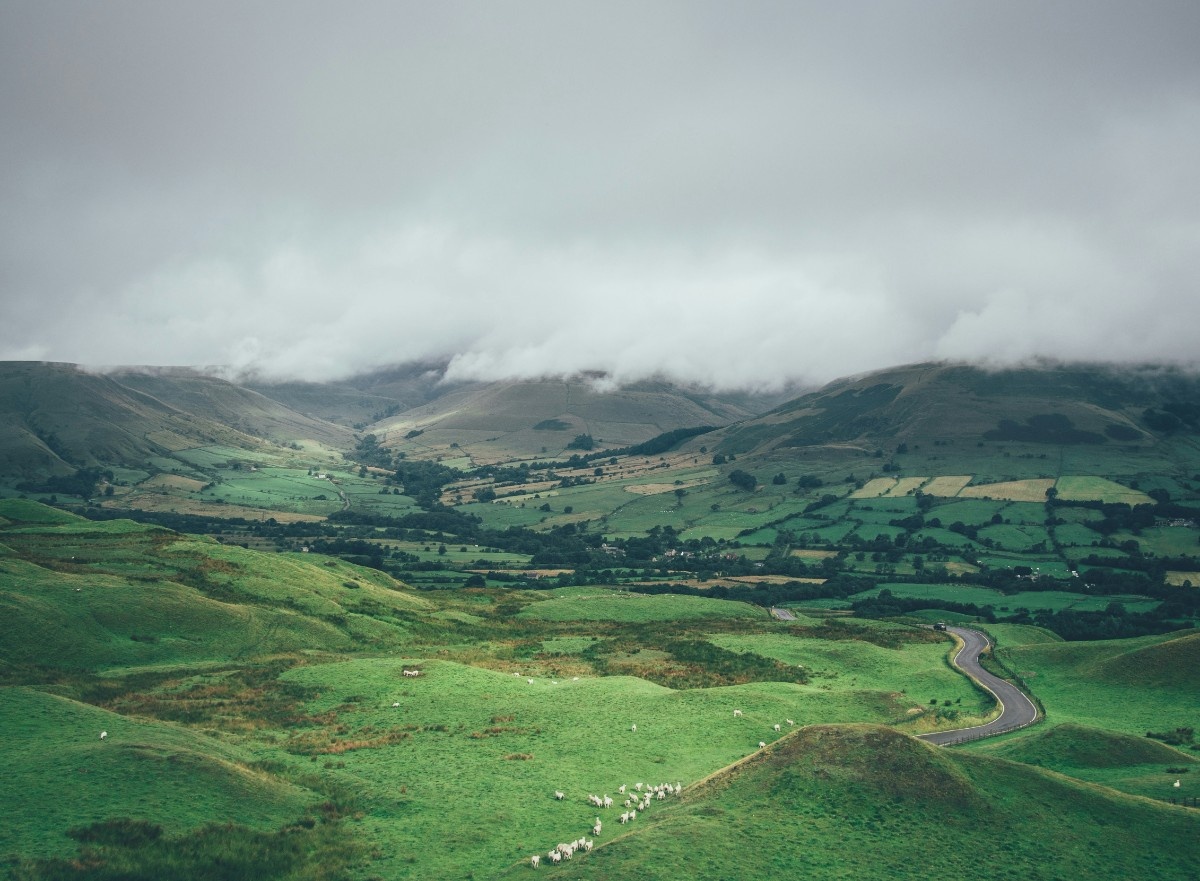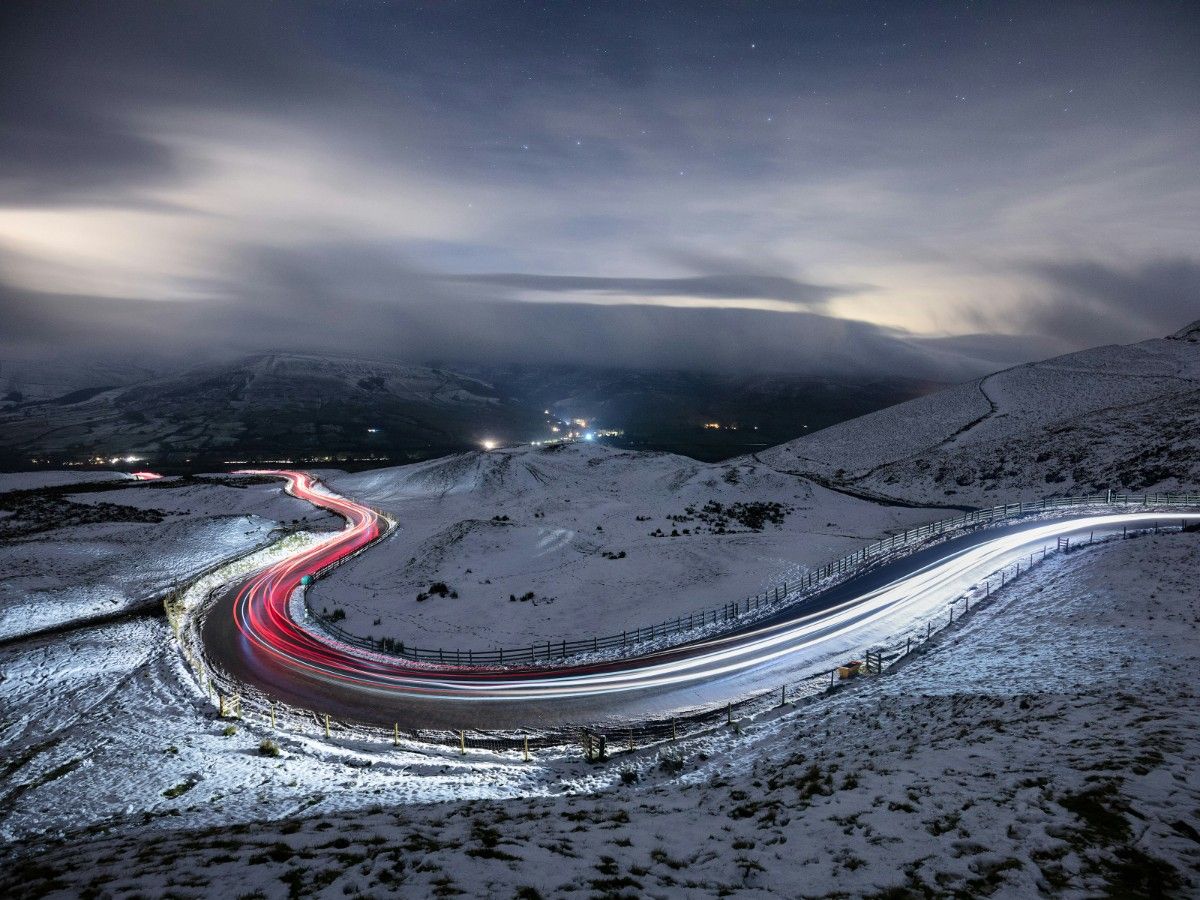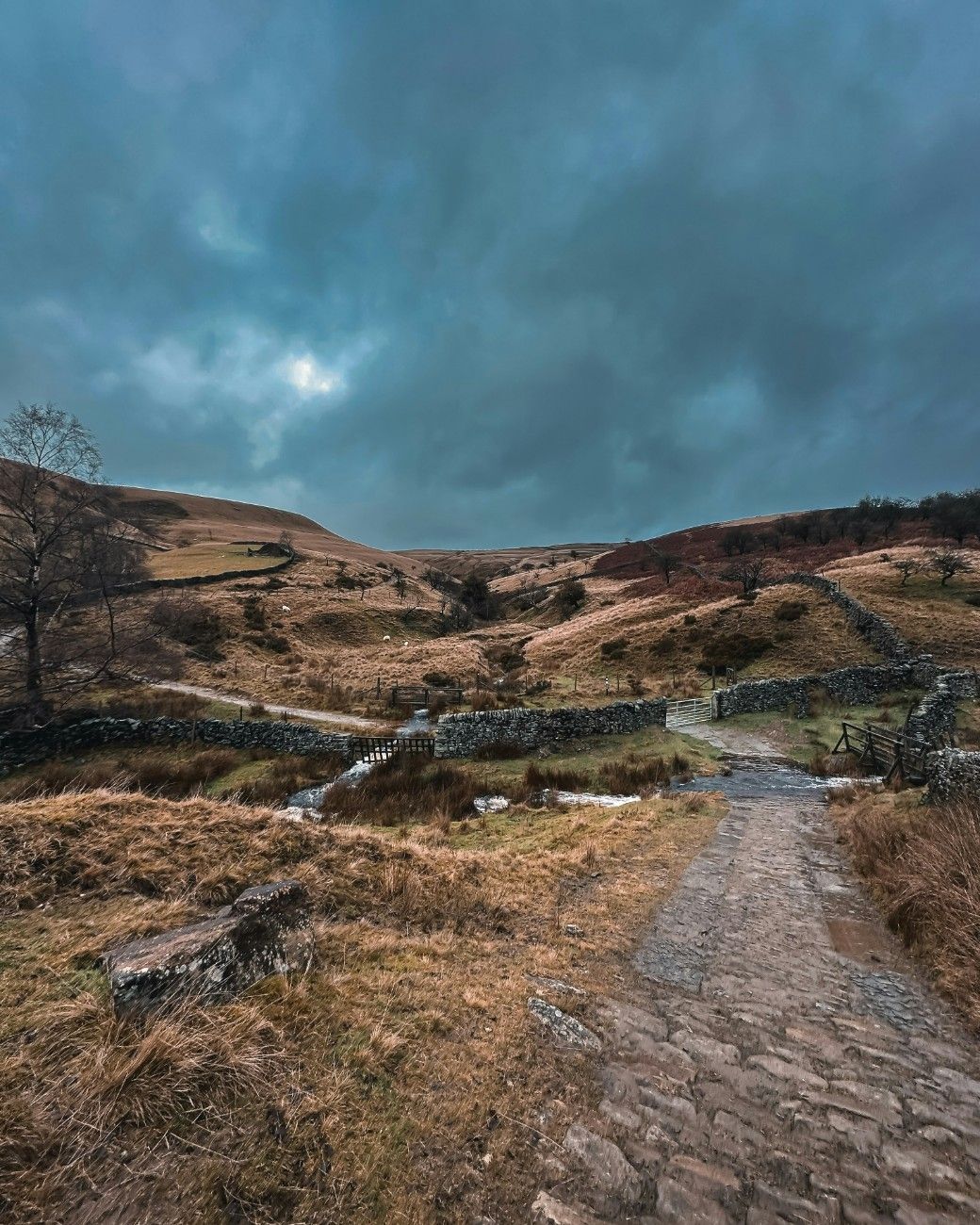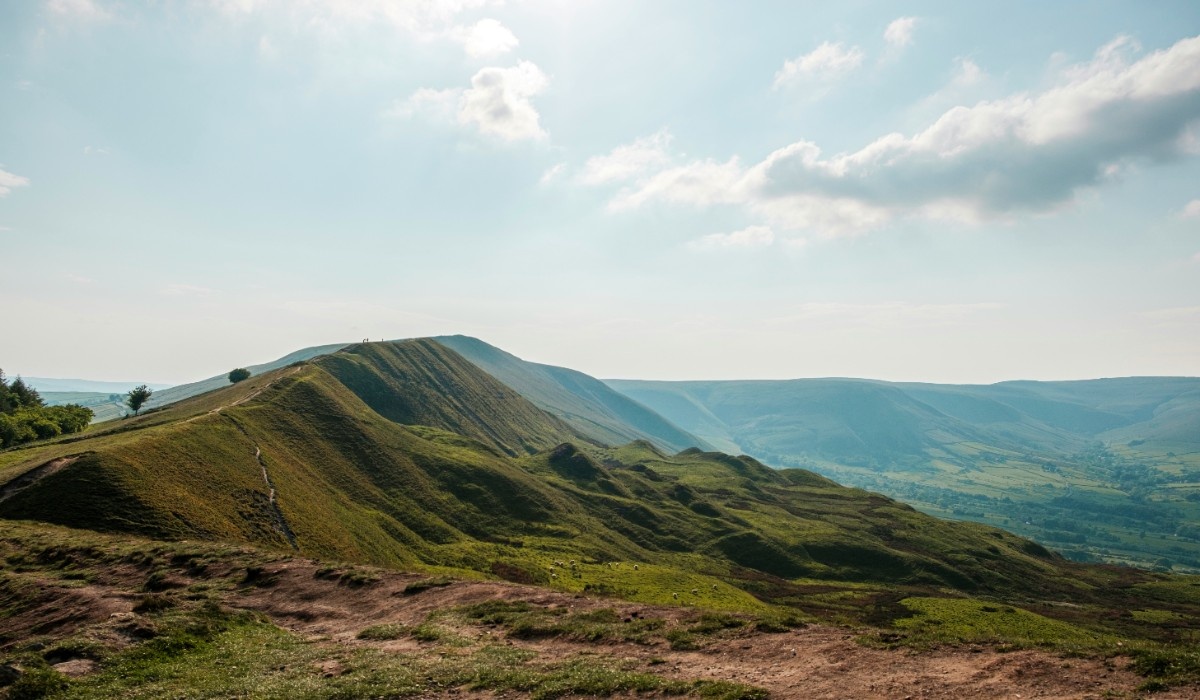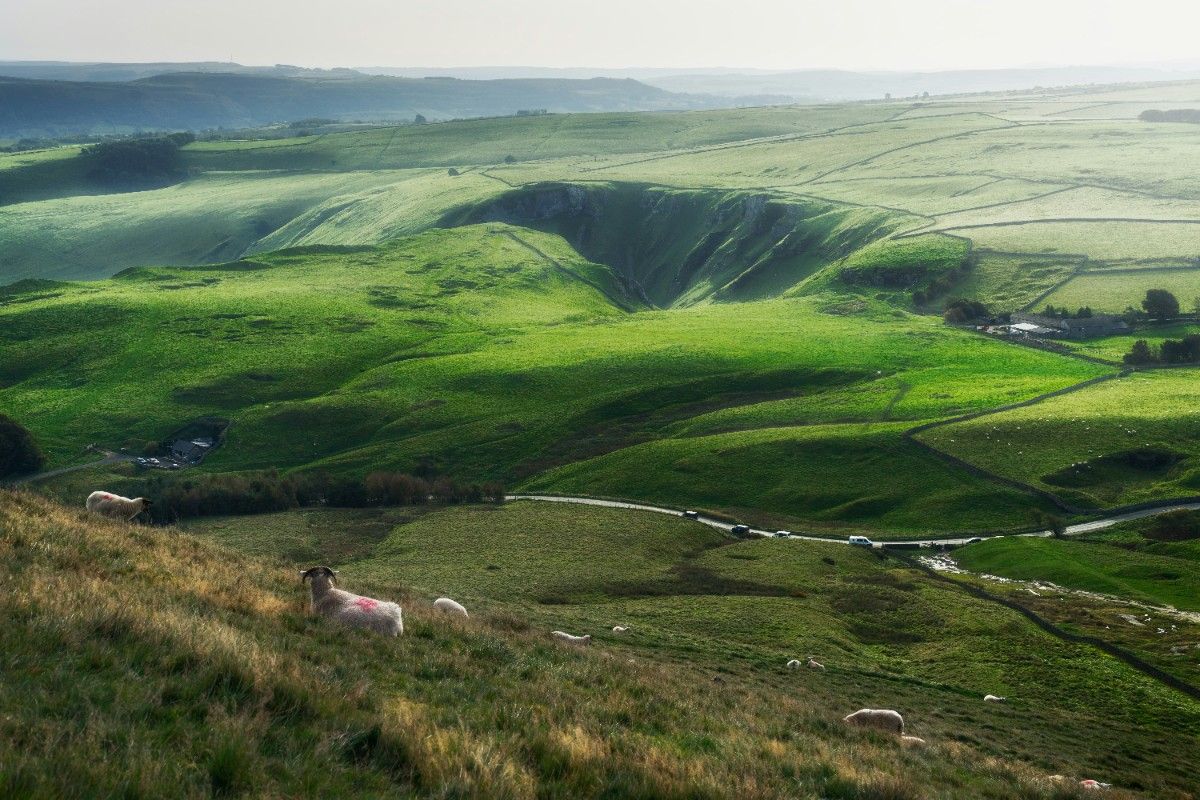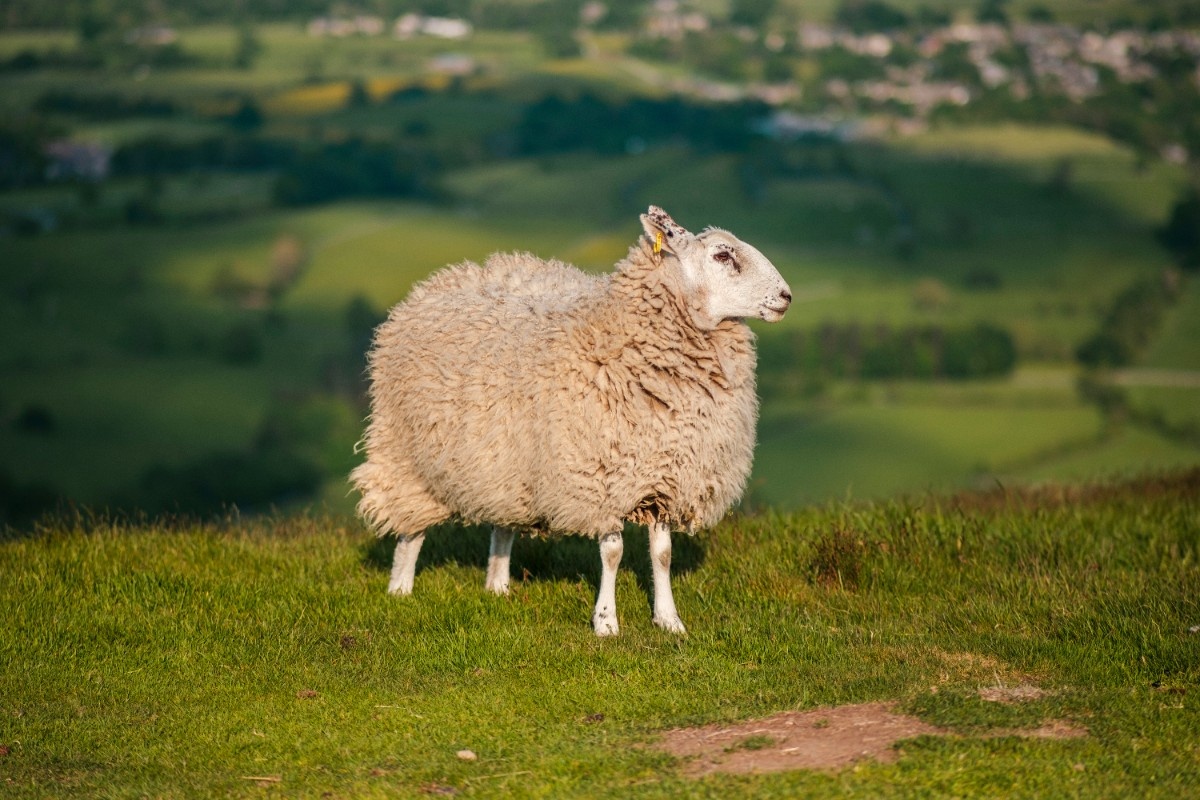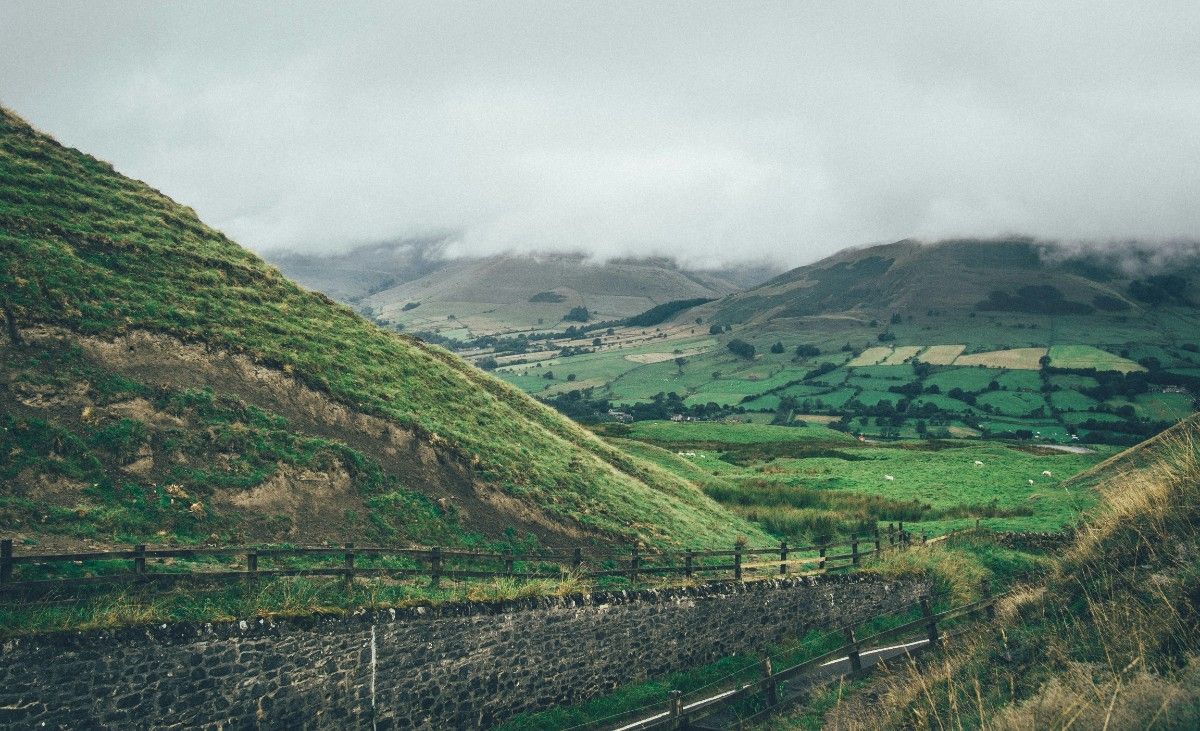Introduction to Mam Tor and Its Surroundings
Geographical Location and Overview
Nestled in the heart of the Peak District National Park, Mam Tor is an iconic hill that captivates visitors with its stunning beauty and rich history. Located near the charming village of Castleton in Derbyshire, this 517-metre (1,696 feet) hill is a true gem of the English countryside. The name "Mam Tor" translates to "Mother Hill" in Old English, a fitting moniker for this majestic landmark that has watched over the surrounding landscape for millennia.
The area around Mam Tor is characterised by rolling hills, lush valleys, and picturesque villages. The Peak District, Britain's first national park, is renowned for its diverse landscapes, ranging from gentle meadows to rugged moorlands. This stunning backdrop provides the perfect setting for outdoor enthusiasts and nature lovers to explore and immerse themselves in the beauty of the English countryside.
Geological Significance
Mam Tor is not only a visual spectacle but also a geological wonder. The hill is composed of shale and sandstone layers that were formed during the Carboniferous period, approximately 320 million years ago. The distinct alternating layers of rock are a testament to the changing environmental conditions during this time, with the shale representing deep-water deposits and the sandstone indicating shallower, river-dominated periods.
The instability of the shale layers has led to frequent landslips over the years, earning Mam Tor the nickname "Shivering Mountain." These landslips have created a unique landscape, with the hill's eastern face being deeply scarred and the road that once ran along its base now abandoned due to the constant movement of the ground. This geological activity has not only shaped the appearance of Mam Tor but also created a haven for rare plant species that thrive in the nutrient-rich, disturbed soil.
Historical and Cultural Significance
In addition to its geological importance, Mam Tor has a rich history that dates back thousands of years. The summit of the hill is home to the remains of an Iron Age hill fort, which was constructed around 1200 BC. This ancient fortification served as a defensive stronghold and a centre for trade and commerce, with its strategically advantageous location providing stunning views of the surrounding landscape.
The area around Mam Tor has also played a significant role in the industrial history of the Peak District. The nearby village of Castleton was once a thriving centre for lead mining, with the hillsides dotted with old mine shafts and remnants of the once-booming industry. Today, visitors can explore this fascinating history by visiting the Castleton Museum or by taking a guided tour of the ancient mines.
Mam Tor and its surroundings have long been a source of inspiration for artists, writers, and poets. The stunning landscapes and rich cultural heritage of the area have been captured in countless works of art, from paintings and photographs to literature and music. This enduring creative legacy is a testament to the enduring beauty and allure of this special place.
Walking Routes and Trails Around Mam Tor
The Mam Tor Circular Walk
One of the most popular walking routes in the area is the Mam Tor Circular Walk, a moderate 5-kilometre (3-mile) trail that offers breathtaking views of the surrounding landscape. The walk begins at the Mam Nick Car Park, located just off the A6187 road between Castleton and Edale. From here, walkers can follow the well-maintained path to the summit of Mam Tor, where they are greeted with panoramic views of the Hope Valley and the distant peaks of Kinder Scout and Rushup Edge.
As you make your way along the trail, you'll pass through lush fields and over ancient stone walls, with the rugged beauty of the Dark Peak area unfolding before you. The path is well-signposted and relatively easy to follow, making it a great option for walkers of all skill levels. Along the way, you'll have the opportunity to spot a variety of wildlife, from soaring birds of prey to grazing sheep and hardy mountain hares.
The Great Ridge Walk
For those looking for a more challenging walk, the Great Ridge Walk is an excellent choice. This 6.5-kilometre (4-mile) linear route follows the ridgeline from Mam Tor to Lose Hill, offering stunning views of the surrounding valleys and peaks. The trail begins at the summit of Mam Tor and follows the undulating ridgeline, passing by the distinctive tors of Hollins Cross, Back Tor, and Lose Hill.
As you make your way along the ridge, you'll be treated to panoramic views of the Hope Valley to the south and the Edale Valley to the north. On a clear day, you can see for miles in every direction, with the distant cities of Manchester and Sheffield visible on the horizon. The trail can be challenging in places, with some steep ascents and descents, but the breathtaking views and sense of accomplishment make it well worth the effort.
The Mam Tor to Losehill via Winnats Pass Walk
For a truly unforgettable walking experience, consider the Mam Tor to Losehill via Winnats Pass Walk. This 10-kilometre (6.2-mile) circular route combines the best of the Great Ridge Walk with a stunning descent through the dramatic Winnats Pass, a deep limestone gorge that cuts through the heart of the Peak District.
The walk begins at the Mam Nick Car Park and follows the same route as the Great Ridge Walk to Lose Hill. From here, walkers descend into the village of Castleton before making their way up the steep-sided Winnats Pass. The gorge is a true geological wonder, with towering limestone cliffs rising up on either side and a narrow, winding road snaking through the centre.
As you make your way through the pass, you'll be treated to stunning views of the surrounding hills and valleys, with the distinctive silhouette of Mam Tor looming in the distance. The trail can be challenging in places, with some steep ascents and rocky terrain, but the incredible scenery and sense of adventure make it a truly unforgettable experience.
Accessibility and Safety Considerations
While the walking routes around Mam Tor offer a range of difficulties and distances, it's important to keep in mind that the terrain can be challenging in places, with steep ascents, rocky paths, and exposed sections. Walkers should always wear appropriate footwear, bring plenty of water and snacks, and be prepared for changeable weather conditions.
For those with limited mobility or fitness levels, there are still plenty of opportunities to enjoy the stunning scenery around Mam Tor. The Mam Nick Car Park offers excellent views of the hill and the surrounding landscape, and there are several shorter, less strenuous walks that can be enjoyed from here.
Regardless of your skill level or fitness, it's always a good idea to let someone know your planned route and estimated return time before setting out on a walk. This simple precaution can help ensure your safety and provide peace of mind as you explore the stunning countryside around Mam Tor.
Viewpoints and Photography Spots at Mam Tor
The Summit: A Panoramic Viewpoint
The summit of Mam Tor is undoubtedly the most iconic viewpoint in the area, offering a stunning 360-degree panorama of the Peak District. At 517 metres (1,696 feet) above sea level, this vantage point provides unparalleled views of the surrounding landscape, including the Hope Valley, Edale Valley, and the distant peaks of Kinder Scout and Rushup Edge.
Photographers will find endless inspiration at the summit, with the changing light and weather conditions creating a dynamic and ever-evolving landscape. At sunrise and sunset, the warm golden light bathes the valleys and hills in a soft, ethereal glow, while the midday sun casts deep shadows and highlights the rugged textures of the terrain.
To capture the best views from the summit, it's recommended to use a wide-angle lens to encompass the sweeping vistas. A sturdy tripod is also essential, particularly in low light conditions or when using slower shutter speeds to capture the movement of clouds or the flow of water in the distant streams.
The Great Ridge: A Photographer's Dream
The Great Ridge, which stretches from Mam Tor to Lose Hill, is a photographer's dream, offering a constantly changing perspective of the surrounding landscape. As you walk along the undulating ridgeline, you'll be treated to stunning views of the Hope Valley and Edale Valley, with the distinctive tors of Hollins Cross, Back Tor, and Lose Hill providing unique focal points.
The ridge is particularly stunning in the early morning or late afternoon, when the low sun casts long shadows and highlights the contours of the land. The golden hour before sunset is a particularly magical time, with the warm light painting the landscape in a rich, fiery glow.
For the best photographs, try to find interesting foreground elements to anchor your shots, such as the gnarled roots of an old tree or a weathered stone wall. These details can add depth and context to your images, while also providing a sense of scale and perspective.
Winnats Pass: A Dramatic Gorge
Winnats Pass, a deep limestone gorge that cuts through the heart of the Peak District, is another must-visit location for photographers. The towering cliffs and narrow, winding road create a dramatic and otherworldly landscape, with the play of light and shadow adding to the ethereal atmosphere.
The best time to photograph Winnats Pass is in the early morning or late afternoon, when the sun is low in the sky and the light is soft and warm. The gorge can be challenging to photograph due to the high contrast between the bright sky and the deep shadows, so it's recommended to use a graduated neutral density filter to balance the exposure.
For a unique perspective, try hiking to the top of the gorge and looking down on the winding road below. This elevated viewpoint offers a stunning vista of the surrounding hills and valleys, with the distinctive silhouette of Mam Tor visible in the distance.
The Villages of Castleton and Edale: Picturesque Charm
The picturesque villages of Castleton and Edale, located at the foot of Mam Tor, offer a wealth of photographic opportunities. With their charming stone cottages, quaint pubs, and historic churches, these villages provide a glimpse into the rich cultural heritage of the Peak District.
In Castleton, be sure to visit the ruins of Peveril Castle, which perches atop a steep hill overlooking the village. The castle provides a stunning backdrop for photographs, particularly at sunset when the warm light illuminates the ancient stones.
Edale, located on the northern side of Mam Tor, is a charming village surrounded by rolling hills and picturesque farmland. The Edale Valley is particularly stunning in the autumn, when the trees are ablaze with vibrant reds, oranges, and golds.
For the best photographs of these villages, try to capture the unique character and charm of the buildings and streets. Look for interesting details, such as a weathered door or a colourful flower box, to add visual interest to your shots. And don't forget to chat with the friendly locals, who are always happy to share their stories and insights into life in the Peak District.
Geological Significance and History of Mam Tor
Formation and Composition
Mam Tor's unique geology is a testament to the complex processes that have shaped the Earth over millions of years. The hill is composed primarily of shale and sandstone layers that were formed during the Carboniferous period, approximately 320 million years ago. At that time, the area that is now the Peak District was covered by a vast, shallow sea, with rivers and deltas depositing sediment into the basin.
The shale layers of Mam Tor are particularly unstable due to their composition of fine-grained particles and high clay content. When exposed to water and air, the shale weathers easily, leading to frequent landslips and the formation of deep scars and gullies on the hill's eastern face. These landslips have been occurring for thousands of years, with the most recent major slip taking place in 1979, resulting in the closure of the main road that once ran along the base of the hill.
In contrast to the unstable shale, the sandstone layers of Mam Tor are more resistant to weathering and erosion. These layers were formed from coarser-grained sediments deposited by rivers and deltas, and they provide a more stable foundation for the hill. The differential weathering of the shale and sandstone layers has created the distinctive stepped appearance of Mam Tor, with the harder sandstone forming steep cliffs and the softer shale creating gentle slopes and terraces.
Influence on the Landscape
The geology of Mam Tor has had a significant impact on the surrounding landscape, shaping not only the hill itself but also the valleys and ridges that surround it. The frequent landslips and erosion of the shale layers have created a constantly changing terrain, with new gullies and scars appearing on the hillside over time.
The Great Ridge, which extends from Mam Tor to Lose Hill, is a prime example of how the geology has influenced the landscape. The ridge is formed from a thick layer of hard sandstone that has resisted erosion, while the softer shale on either side has been worn away to create the deep valleys of Hope and Edale.
The geology of Mam Tor has also had an impact on the human history of the area. The unstable nature of the shale has made it difficult to build on or cultivate the land, limiting human settlement and agriculture. However, the presence of lead and other minerals in the rock layers has attracted mining activity to the area for centuries, with the nearby village of Castleton once a thriving centre of lead mining.
Landslips and Road Closure
One of the most notable events in the recent history of Mam Tor was the closure of the A625 road that once ran along the base of the hill. The road, which connected the villages of Chapel-en-le-Frith and Castleton, had been plagued by frequent landslips and subsidence since its construction in the early 19th century.
In 1979, a major landslip occurred on the eastern face of Mam Tor, causing a large section of the road to collapse. The road was subsequently closed to traffic, and despite initial attempts to repair and stabilise the hillside, it was eventually decided that the cost and risk of maintaining the road were too high.
Today, the abandoned road provides a stark reminder of the power and unpredictability of the geological forces that shape our planet. The twisted and buckled tarmac, with its cracks and fissures, is a popular spot for photographers and visitors, offering a unique insight into the ever-changing nature of the landscape.
Importance for Study and Research
The unique geology of Mam Tor has made it an important site for scientific study and research. The hill is a designated Site of Special Scientific Interest (SSSI) due to its geological and ecological significance, and it has been the subject of numerous studies over the years.
The frequent landslips and erosion of the shale layers provide a rare opportunity for geologists to study the processes of mass movement and slope stability in real-time. By monitoring the movement of the hillside and analysing the factors that contribute to landslips, scientists can gain valuable insights into the complex interplay of geology, hydrology, and climate that shape our planet.
In addition to its geological significance, Mam Tor is also an important site for ecological research. The disturbed and nutrient-rich soils created by the landslips provide a unique habitat for a range of rare and specialised plant species, including the Derbyshire Feather Moss and the Mam Tor Blackthorn. The hill is also home to a diverse array of wildlife, including birds of prey, mountain hares, and various invertebrates.
The ongoing study and research at Mam Tor is crucial for understanding the complex and dynamic processes that shape our planet, and for developing strategies to manage and mitigate the impacts of geological hazards such as landslips and erosion. By continuing to monitor and study this unique and fascinating site, scientists can gain valuable insights that will help us to better understand and protect our natural world for generations to come.
Flora and Fauna of Mam Tor and the Surrounding Area
Unique Habitats and Ecosystems
Mam Tor and the surrounding Peak District are home to a diverse array of flora and fauna, thanks to the unique combination of geology, altitude, and climate. The hill's shale and sandstone layers, combined with the frequent landslips and erosion, have created a mosaic of habitats that support a wide range of species.
One of the most distinctive habitats on Mam Tor is the limestone grassland, which is characterised by thin, nutrient-poor soils and a specialised plant community. The grassland is home to a range of rare and endemic species, including the Derbyshire Feather Moss and the Mam Tor Blackthorn, which are found nowhere else in the world.
The hill's rocky outcrops and scree slopes provide a habitat for a range of hardy, adapted plant species, such as the Mam Tor Hawkweed and the Frog Orchid. These plants are able to thrive in the harsh, exposed conditions, and they provide a vital food source for a range of invertebrates and other wildlife.
The valleys and streams that surround Mam Tor are also important habitats, supporting a range of aquatic and semi-aquatic species. The River Noe, which flows through the Hope Valley, is home to a healthy population of brown trout, as well as a range of invertebrates such as mayflies and caddisflies.
Notable Plant Species
Mam Tor and the surrounding area are home to a number of notable plant species, many of which are rare or endemic to the region. One of the most distinctive is the Jacob's Ladder, a beautiful blue wildflower that grows on the hill's limestone grasslands. The plant is named for its ladder-like arrangement of leaves, and it is a popular subject for photographers and nature lovers.
Another notable species is the Mountain Pansy, a small, yellow wildflower that grows on the rocky outcrops and scree slopes of Mam Tor. The plant is well-adapted to the harsh, exposed conditions, and it provides a vital source of nectar for a range of invertebrates.
The Mam Tor Blackthorn is a rare hybrid of the native blackthorn and the non-native cherry plum. The tree is found only on the slopes of Mam Tor, and it is a fascinating example of how new species can arise through hybridisation and adaptation to local conditions.
Other notable plant species on Mam Tor include the Limestone Bedstraw, the Fairy Flax, and the Mam Tor Hawkweed. These species are all adapted to the unique conditions on the hill, and they play important roles in the local ecosystem.
Bird and Animal Life
Mam Tor and the surrounding area are home to a diverse array of bird and animal life, thanks to the range of habitats and food sources available. The hill's rocky outcrops and scree slopes provide nesting sites for a range of birds, including the Peregrine Falcon, the Raven, and the Ring Ouzel.
The valleys and streams around Mam Tor are also important habitats for birds, with species such as the Dipper and the Grey Wagtail commonly seen along the riverbanks. The woodlands and hedgerows in the area provide habitats for a range of songbirds, including the Willow Warbler and the Chiffchaff.
Mammals are also well-represented in the area, with species such as the Red Deer, the Badger, and the Fox commonly seen in the surrounding countryside. The hill's rocky outcrops and scree slopes provide habitats for smaller mammals such as the Stoat and the Weasel, which prey on the abundant invertebrates and small birds in the area.
One of the most iconic mammals on Mam Tor is the Mountain Hare, which is well-adapted to the harsh, exposed conditions on the hill. The hare's coat changes colour with the seasons, turning white in the winter to provide camouflage against the snow. The presence of mountain hares on Mam Tor is a testament to the unique and varied ecology of the area, and they are a popular subject for photographers and wildlife enthusiasts.
Conservation and Protection
The unique and diverse flora and fauna of Mam Tor and the surrounding area are protected by a range of conservation measures and designations. The hill is located within the Peak District National Park, which was established in 1951 to protect and enhance the natural beauty, wildlife, and cultural heritage of the area.
Mam Tor itself is designated as a Site of Special Scientific Interest (SSSI) due to its geological and ecological significance. This designation provides legal protection for the hill's unique habitats and species, and ensures that any development or land use changes are carefully managed to minimise impacts on the environment.
The National Trust, a charity that works to protect and preserve natural and historical sites across the UK, owns and manages much of the land around Mam Tor. The Trust works to maintain and enhance the hill's unique habitats and species through a range of conservation measures, such as grazing management, invasive species control, and habitat restoration.
Conservation organisations such as the Derbyshire Wildlife Trust and the RSPB (Royal Society for the Protection of Birds) also play important roles in protecting and enhancing the flora and fauna of Mam Tor and the surrounding area. These organisations work to monitor and study the hill's unique species and habitats, and they provide advice and support to landowners and managers to help them protect and enhance the natural environment.
Visitors to Mam Tor can also play a role in conserving the hill's flora and fauna by following the Countryside Code and taking care to minimise their impact on the environment. This includes sticking to designated footpaths and trails, keeping dogs on a lead, and taking litter home. By working together to protect and enhance the natural beauty and diversity of Mam Tor, we can ensure that this unique and special place remains a haven for wildlife and a source of inspiration and enjoyment for generations to come.
Best Times to Visit Mam Tor and Weather Considerations
Seasonal Highlights and Attractions
Mam Tor is a stunning destination year-round, with each season offering its own unique charms and attractions. In spring, the hill comes alive with wildflowers and birdlife, as the warmer weather and longer days bring a burst of colour and activity to the landscape. The limestone grasslands are particularly beautiful at this time of year, with species such as Jacob's Ladder and Early Purple Orchid in full bloom.
Summer is the busiest time of year on Mam Tor, with the warm weather and long daylight hours drawing visitors from far and wide. The hill's summit and ridges offer stunning views of the surrounding countryside, and the longer days provide plenty of opportunities for exploring the area's many walking trails and attractions.
In autumn, Mam Tor takes on a new character as the leaves of the surrounding trees turn shades of gold, red, and brown. The cooler temperatures and shorter days make for comfortable walking conditions, and the hill's rocky outcrops and scree slopes provide a stark and dramatic contrast to the colourful foliage.
Winter on Mam Tor can be a challenging but rewarding time to visit, with the hill often blanketed in snow and ice. The white, frosty landscape is a photographer's dream, and the crisp, clear air provides stunning views of the surrounding countryside. However, winter conditions on the hill can be harsh and unpredictable, with strong winds, low temperatures, and icy surfaces making for challenging walking conditions.
Weather Patterns and Considerations
The weather on Mam Tor can be highly variable and unpredictable, with conditions changing rapidly throughout the day and between seasons. The hill's exposed location and high altitude mean that it is often subject to strong winds, low temperatures, and heavy precipitation.
In spring and summer, the weather on Mam Tor is generally milder and more settled, with average daytime temperatures ranging from 10-20°C. However, the hill can still experience sudden changes in weather, with rain showers and strong winds possible at any time.
In autumn and winter, the weather on Mam Tor becomes more challenging, with average daytime temperatures dropping to 0-10°C and the potential for snow, ice, and strong winds increasing. The hill's exposed location means that it can feel much colder than the surrounding lowlands, and the risk of hypothermia and other cold-related injuries is higher.
Visitors to Mam Tor should always check the weather forecast before setting out, and be prepared for sudden changes in conditions. It is essential to wear appropriate clothing and footwear, and to carry extra layers, waterproofs, and emergency supplies in case of unexpected changes in the weather.
Recommended Times to Visit
The best time to visit Mam Tor depends on your interests and preferences, as well as your tolerance for different weather conditions. For those seeking mild temperatures and settled weather, late spring and early summer (May-June) are generally the best times to visit. This is also a great time for wildflower enthusiasts, as the hill's limestone grasslands are in full bloom.
For those seeking quieter conditions and autumnal colours, September and October can be excellent times to visit Mam Tor. The cooler temperatures and shorter days make for comfortable walking conditions, and the changing colours of the surrounding foliage provide a stunning backdrop for photography and nature appreciation.
Winter visits to Mam Tor are best suited to experienced hikers and those with a high tolerance for challenging weather conditions. The hill can be blanketed in snow and ice, making for difficult and potentially dangerous walking conditions. However, for those equipped with the right gear and experience, a winter hike on Mam Tor can be a truly unforgettable experience.
Ultimately, the best time to visit Mam Tor is whenever you have the opportunity to do so. The hill's stunning views, unique geology, and diverse flora and fauna make it a worthwhile destination at any time of year. By being prepared for the weather conditions and taking appropriate precautions, you can enjoy the many wonders of this special place in any season.
Accessibility and Safety Considerations
Mam Tor is a popular destination for hikers and outdoor enthusiasts, but it is important to be aware of the hill's accessibility and safety considerations before setting out. The hill's summit and ridges are accessed via a network of well-maintained footpaths and trails, but these can be steep, uneven, and exposed in places.
The main footpath to the summit of Mam Tor starts from the Mam Nick car park and follows a well-defined route up the hill's northern flank. The path is steep in places, with some rocky steps and sections of loose gravel, but it is generally well-maintained and suitable for most hikers with a reasonable level of fitness.
The Great Ridge path, which runs along the hill's eastern flank, is a more challenging route that requires a higher level of fitness and experience. The path is narrow and exposed in places, with steep drops on either side, and can be slippery and treacherous in wet or icy conditions.
Visitors to Mam Tor should always wear appropriate footwear with good grip and ankle support, and carry extra layers and waterproofs in case of sudden changes in the weather. It is also important to carry a map and compass, and to know how to use them, as the hill's network of paths and trails can be confusing in poor visibility.
In case of emergency, visitors should carry a fully charged mobile phone and know how to contact the emergency services. The hill's remote location and challenging terrain can make rescue operations difficult and time-consuming, so it is important to be prepared and to take all necessary precautions to stay safe.
Overall, Mam Tor is a stunning and rewarding destination for hikers and outdoor enthusiasts of all levels. By being aware of the hill's accessibility and safety considerations, and taking appropriate precautions, visitors can enjoy the many wonders of this special place while staying safe and comfortable in any weather conditions.
Accommodations and Amenities Near Mam Tor
Camping and Caravanning Options
For those seeking an immersive outdoor experience, camping and caravanning are popular options for accommodations near Mam Tor. The hill is located within the Peak District National Park, which offers a range of camping and caravanning sites to suit different preferences and budgets.
One of the closest camping sites to Mam Tor is the Fieldhead Campsite, located just a short walk from the hill's main car park. The site offers a range of pitches for tents, caravans, and motorhomes, as well as basic amenities such as toilets, showers, and a shop selling essential supplies.
Another popular camping site near Mam Tor is the North Lees Campsite, located in the nearby village of Hathersage. The site offers a range of pitches for tents and caravans, as well as glamping options such as yurts and tipis. The site also has a range of amenities, including hot showers, toilets, and a bar and restaurant.
For those seeking a more luxurious camping experience, the Pindale Farm Outdoor Centre offers a range of glamping options, including bell tents, yurts, and pods. The site is located just a short drive from Mam Tor and offers stunning views of the surrounding countryside.
Bed and Breakfast and Guesthouse Options
For those seeking a more comfortable and traditional accommodation option, there are a range of bed and breakfast and guesthouse options near Mam Tor. The hill is located within easy reach of several charming villages and towns, each offering a range of accommodation options to suit different preferences and budgets.
One of the closest villages to Mam Tor is Castleton, which offers a range of bed and breakfast and guesthouse options. The Causeway House B&B is a popular choice, offering comfortable rooms and a delicious breakfast made with locally sourced ingredients. Another popular option in Castleton is the Innkeeper's Lodge, which offers cosy rooms and an on-site pub and restaurant.
The nearby village of Hope also offers a range of accommodation options, including the Losehill House Hotel and Spa. This luxurious hotel offers stunning views of the surrounding countryside and a range of amenities, including a spa, restaurant, and bar.
For those seeking a more budget-friendly option, the YHA (Youth Hostel Association) offers a range of hostels near Mam Tor, including the YHA Castleton and the YHA Edale. These hostels offer a range of dorm-style and private rooms, as well as communal kitchens and living areas.
Local Pubs and Restaurants
After a day of hiking and exploring on Mam Tor, many visitors enjoy relaxing and refuelling at one of the local pubs or restaurants. The hill is located within easy reach of several charming villages and towns, each offering a range of dining options to suit different tastes and budgets.
In the village of Castleton, the Castle Hotel is a popular choice for a post-hike pint or meal. The hotel's pub and restaurant offer a range of local ales and hearty, traditional British fare, as well as stunning views of the village's castle ruins.
Another popular dining option in Castleton is the 1530 Restaurant, which offers a range of classic British dishes made with locally sourced ingredients. The restaurant also has a cosy bar area, perfect for enjoying a pre-dinner drink or nightcap.
In the nearby village of Hope, the Cheshire Cheese Inn is a popular choice for a pub lunch or dinner. The inn offers a range of classic pub fare, as well as a selection of local ales and ciders.
For those seeking a more upscale dining experience, the Samuel Fox Country Inn in the village of Bradwell offers a range of contemporary British dishes made with locally sourced ingredients. The inn also has a cosy bar area and a range of local ales and wines.
Nearby Attractions and Activities
In addition to hiking and exploring on Mam Tor, there are a range of other attractions and activities to enjoy in the surrounding area. The hill is located within the Peak District National Park, which offers a wealth of opportunities for outdoor recreation and nature appreciation .
One of the most popular attractions near Mam Tor is the Blue John Cavern, a stunning underground cave system famous for its unique Blue John stone. Visitors can take guided tours of the cavern and learn about its fascinating geology and history, as well as admire the stunning rock formations and colours.
Another popular attraction near Mam Tor is the Peveril Castle, a stunning medieval fortress perched high above the village of Castleton. Visitors can explore the castle's ruins and learn about its fascinating history, as well as enjoy stunning views of the surrounding countryside.
For those interested in outdoor activities, the Peak District offers a range of options, including rock climbing, mountain biking, and horseback riding. The nearby Stanage Edge is a popular spot for rock climbing, while the Tissington Trail offers a scenic route for mountain biking and horseback riding.
Other nearby attractions include the Eyam Museum, which tells the fascinating story of the village's response to the plague in the 17th century, and the Chatsworth House, a stunning stately home set in beautiful gardens and parkland.
Responsible Tourism and Conservation Efforts at Mam Tor
Environmental Impact of Tourism
As a popular destination for hikers and outdoor enthusiasts, Mam Tor and the surrounding Peak District National Park face a range of environmental challenges related to tourism. Visitors to the area can have a significant impact on the delicate ecosystems and habitats of the region, as well as on the local communities and infrastructure.
One of the main environmental impacts of tourism on Mam Tor is erosion and damage to the hill's footpaths and trails. The high volume of foot traffic on the hill can lead to soil compaction, vegetation loss, and damage to the hill's unique geology and landforms. This can have a negative impact on the hill's biodiversity and ecosystem health, as well as on the visitor experience.
Another environmental impact of tourism on Mam Tor is littering and waste management. Visitors to the hill and surrounding areas generate a significant amount of waste, including food packaging, drinks containers, and other litter. This can have a negative impact on the hill's aesthetic beauty and ecosystem health, as well as on the local communities and infrastructure.
Sustainable Tourism Initiatives
To mitigate the environmental impact of tourism on Mam Tor and the surrounding Peak District, a range of sustainable tourism initiatives have been implemented in recent years. These initiatives aim to promote responsible and sustainable tourism practices, while also protecting and enhancing the natural and cultural heritage of the region.
One of the main sustainable tourism initiatives on Mam Tor is the Peak District National Park Authority's "Take a Peak District" campaign. This campaign encourages visitors to the national park to "take nothing but photos, leave nothing but footprints, and kill nothing but time." The campaign promotes responsible tourism practices such as sticking to designated footpaths, taking litter home, and respecting wildlife and habitats.
Another sustainable tourism initiative on Mam Tor is the National Trust's "Mam Tor and the Great Ridge" project. This project aims to protect and enhance the unique geology, ecology, and cultural heritage of Mam Tor and the surrounding area, while also promoting sustainable tourism practices. The project includes a range of activities, such as footpath maintenance, habitat restoration, and visitor education and interpretation.
Visitor Responsibility and Stewardship
Visitors to Mam Tor and the surrounding Peak District have an important role to play in promoting sustainable tourism and protecting the natural and cultural heritage of the region. By adopting responsible and sustainable tourism practices, visitors can help to minimise their environmental impact and support local conservation efforts.
Some key ways that visitors can promote sustainable tourism on Mam Tor include:
- Sticking to designated footpaths and trails to minimise erosion and damage to vegetation and habitats
- Taking litter home and disposing of waste responsibly to minimise pollution and protect ecosystem health
- Respecting wildlife and habitats by keeping a safe distance and not disturbing or feeding animals
- Supporting local businesses and communities by buying locally produced goods and services
- Learning about the natural and cultural heritage of the region and sharing this knowledge with others
By adopting these responsible tourism practices, visitors to Mam Tor can help to ensure that the hill and surrounding areas remain a cherished and protected landscape for generations to come.
Conservation and Restoration Efforts
In addition to promoting sustainable tourism practices, a range of conservation and restoration efforts are underway on Mam Tor and in the surrounding Peak District to protect and enhance the region's natural and cultural heritage.
One of the main conservation efforts on Mam Tor is the restoration and maintenance of the hill's unique geology and landforms. The hill's shale and sandstone layers are prone to erosion and landslides, which can have a negative impact on the hill's ecology and visitor safety. To mitigate these impacts, the National Trust and other conservation organisations work to stabilise and restore eroded areas, as well as to monitor and manage the hill's geology and hydrology.
Another important conservation effort on Mam Tor is the protection and enhancement of the hill's biodiversity and habitats. The hill is home to a range of rare and important plant and animal species, including the Twite, a small finch that breeds on the hill's moorland edges. To protect these species and their habitats, conservation organisations work to manage grazing levels, restore degraded areas, and monitor populations and ecosystem health.
Other conservation efforts in the surrounding Peak District include the restoration of native woodlands, the protection of rivers and streams, and the preservation of historic buildings and landscapes. These efforts aim to protect and enhance the region's natural and cultural heritage, while also promoting sustainable tourism and community development.
Ultimately, the conservation and restoration of Mam Tor and the surrounding Peak District requires a collaborative effort between conservation organisations, local communities, and visitors. By working together to promote sustainable tourism practices and support conservation efforts, we can ensure that this iconic landscape remains a cherished and protected part of Britain's natural and cultural heritage for generations to come.
Related Articles

Let us know you agree to cookies
We use marketing, analytical and functional cookies as well as similar technologies to give you the best experience. Third parties, including social media platforms, often place tracking cookies on our site to show you personalised adverts outside of our website.
We store your cookie preferences for two years and you can edit your preferences via ‘manage cookies’ or through the cookie policy at the bottom of every page. For more information, please see our cookie policy.
